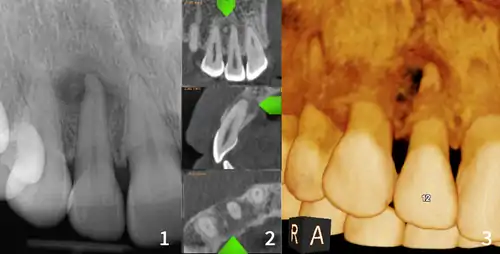Cemento-osseous dysplasia
Cemento-osseous dysplasia (COD) is a benign condition of the jaws that may arise from the fibroblasts of the periodontal ligaments. It is most common in African-American females. The three types are periapical cemental dysplasia (common in those of African descent), focal cemento-osseous dysplasia (Caucasians), and florid cemento-osseous dysplasia (African descent). Periapical occurs most commonly in the mandibular anterior teeth while focal appears predominantly in the mandibular posterior teeth and florid in both maxilla and mandible in multiple quadrants.
| Cemento-osseous dysplasia | |
|---|---|
| Other names | Florid osseous dysplasia |
 | |
| Florid osseous dysplasia of the mandible | |
| Specialty | Dentistry |
| Symptoms | Assymptomatic, radiographic finding |
| Complications | Infection with extractions or abscessed teeth, unnecessary root canals |
| Usual onset | 20-30 years |
| Types | Localized, generalized |
| Causes | Congenital |
| Diagnostic method | X-ray, CBCT scan, vitality testing of teeth |
| Differential diagnosis | Paget's disease of bone, fibrous dysplasia, Tooth abscess |
| Treatment | None required |
Diagnosis
Diagnosis is important so that the treating doctor does not confuse it for another periapical disease such as rarefying osteitis or condensing osteitis. Incorrect diagnosis could lead to unnecessary root canal treatments. It can be diagnosed by radiographic appearance. Confirming the tooth is vital, as is noting the demographic (African American females).
Treatment
There is no treatment necessary for any type of COD.

References
- Kahn, Michael A. Basic Oral and Maxillofacial Pathology. Volume 1. 2001.
- Neville and Damm. Oral and Maxillofacial Pathology, 3rd Edition. 2012.